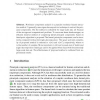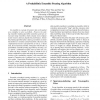2826 search results - page 17 / 566 » Maximal Vector Computation in Large Data Sets |
ICML
1998
IEEE
14 years 8 months ago
1998
IEEE
Computational comparison is made between two feature selection approaches for nding a separating plane that discriminates between two point sets in an n-dimensional feature space ...
CIKM
2009
Springer
13 years 5 months ago
2009
Springer
In this paper, we present a framework for mining diverging patterns, a new type of contrast patterns whose frequency changes significantly differently in two data sets, e.g., it c...
ICPR
2004
IEEE
14 years 9 months ago
2004
IEEE
Gesture recognition is a difficult task in computer vision due to the numerous degrees of freedom of a human hand. Fortunately, human gesture covers only a small part of the theor...
ISNN
2009
Springer
14 years 2 months ago
2009
Springer
Abstract. Nonlinear component analysis is a popular nonlinear feature extraction method. It generally uses eigen-decomposition technique to extract the principal components. But th...
ICDM
2006
IEEE
14 years 1 months ago
2006
IEEE
An ensemble is a group of learners that work together as a committee to solve a problem. However, the existing ensemble training algorithms sometimes generate unnecessary large en...


